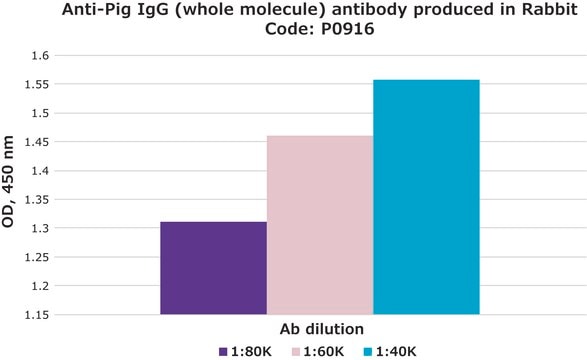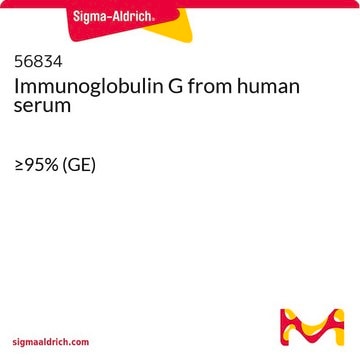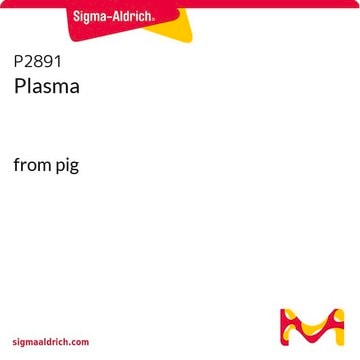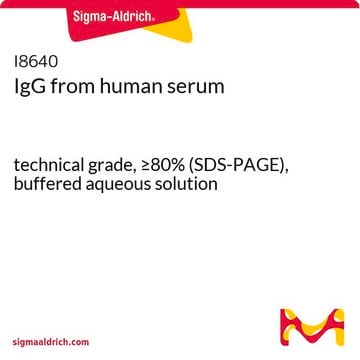I4381
IgG from porcine serum
reagent grade, ≥95% (SDS-PAGE), essentially salt-free, lyophilized powder
Synonim(y):
Pig IgG
Zaloguj sięWyświetlanie cen organizacyjnych i kontraktowych
About This Item
Polecane produkty
białko sprzężone
unconjugated
klasa czystości
reagent grade
Próba
≥95% (SDS-PAGE)
Postać
essentially salt-free, lyophilized powder
metody
ELISA: suitable
temp. przechowywania
2-8°C
docelowa modyfikacja potranslacyjna
unmodified
Opis ogólny
IgG antibody subtype is the most abundant serum immunoglobulins of the immune system. It is secreted by B cells and is found in blood and extracellular fluids and provides protection from infections caused by bacteria, fungi and viruses. Maternal IgG is transferred to fetus through the placenta that is vital for immune defence of the neonate against infections. IgG from porcine serum specifically recognizes IgG from pig. Pig IgG is purified from normal pig serum by fractionation and ion-exchange chromatography. Immunoglobulin G (IgG) is part of the immunoglobulin family. The primary structure of this antibody contains disulfide bonds involved in linking the two heavy chains, linking the heavy and light chains and resides inside the chains.
Zastosowanie
IgG from porcine serum may be used in quantitative ELISA, a concentration of 0.5 μg/ml may be used as standard. Concentrations ranging from 3.9 to 250 ng/ml were used as standards in immune response measurements. Pig IgG was also used as standard in surface plasmon resonance phase imaging studies.
Oświadczenie o zrzeczeniu się odpowiedzialności
Unless otherwise stated in our catalog or other company documentation accompanying the product(s), our products are intended for research use only and are not to be used for any other purpose, which includes but is not limited to, unauthorized commercial uses, in vitro diagnostic uses, ex vivo or in vivo therapeutic uses or any type of consumption or application to humans or animals.
This page may contain text that has been machine translated.
Kod klasy składowania
11 - Combustible Solids
Klasa zagrożenia wodnego (WGK)
WGK 3
Temperatura zapłonu (°F)
Not applicable
Temperatura zapłonu (°C)
Not applicable
Środki ochrony indywidualnej
Eyeshields, Gloves, type N95 (US)
Certyfikaty analizy (CoA)
Poszukaj Certyfikaty analizy (CoA), wpisując numer partii/serii produktów. Numery serii i partii można znaleźć na etykiecie produktu po słowach „seria” lub „partia”.
Masz już ten produkt?
Dokumenty związane z niedawno zakupionymi produktami zostały zamieszczone w Bibliotece dokumentów.
Klienci oglądali również te produkty
Kelly A Rich et al.
Gene therapy, 29(9), 513-519 (2021-11-23)
Numerous pediatric neurogenetic diseases may be optimally treated by in utero gene therapy (IUGT); but advancing such treatments requires animal models that recapitulate developmental physiology relevant to humans. One disease that could benefit from IUGT is the autosomal recessive motor
Simone Ladel et al.
Pharmaceutics, 10(3) (2018-07-28)
The use of therapeutic antibodies for the treatment of neurological diseases is of increasing interest. Nose-to-brain drug delivery is one strategy to bypass the blood brain barrier. The neonatal Fc receptor (FcRn) plays an important role in transepithelial transcytosis of
Kuo-Hoong Lee et al.
Biosensors & bioelectronics, 23(4), 466-472 (2007-07-10)
This study reports a microfluidic chip integrated with an arrayed immunoassay for surface plasmon resonance (SPR) phase imaging of specific bio-samples. The SPR phase imaging system uses a surface-sensitive optical technique to detect two-dimensional (2D) spatial phase variation caused by
Michael Bailey et al.
Clinical and diagnostic laboratory immunology, 11(2), 337-343 (2004-03-12)
Normal piglets weaned onto soy- or egg-based diets generated antibody responses to fed protein. Concurrent infection with transmissible gastroenteritis virus (TGEV) did not affect the responses to dietary antigens at weaning, nor did it affect the subsequent development of tolerance.
Kateryna Goncharova et al.
PloS one, 12(6), e0180002-e0180002 (2017-06-29)
Neurological disorders are among the main clinical problems affecting preterm children and often result in the development of communication and learning disabilities later in life. Several factors are of importance for brain development, however the role of immunoglobulins (passive immunity
Nasz zespół naukowców ma doświadczenie we wszystkich obszarach badań, w tym w naukach przyrodniczych, materiałoznawstwie, syntezie chemicznej, chromatografii, analityce i wielu innych dziedzinach.
Skontaktuj się z zespołem ds. pomocy technicznej













